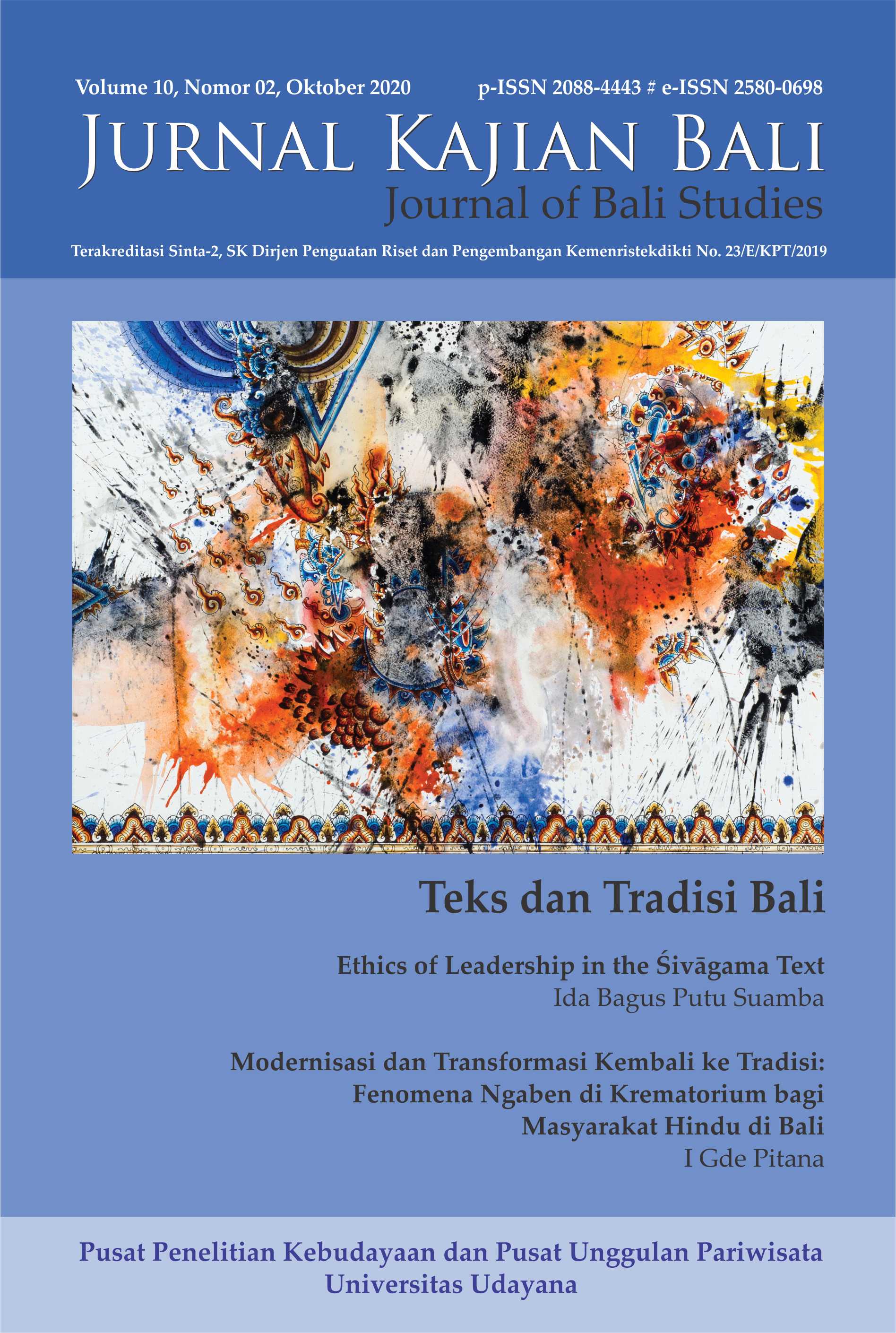Ekspresi Verbal Masyarakat Bali terhadap Kelahiran Bayi: Kajian Linguistik Kebudayaan
Abstrak
This article is aimed to describe the verbal expression given by the Balinese community to the birth of a baby by examining the core of verbal expression in the use of diction. In the context of discourse, the choices of words used are not only due to chances, but also ideologically showing how the meaning of community facts and reality. Data analysis indicated that these are the differences in the use of word choices between verbal expression for baby boys and girls. The verbal expression for baby boys contains exceptional semantic features focusing on happiness. Meanwhile, for baby girls, there are more prayers and hopes for their household chores. Besides, those verbal expressions given were found containing gender inequality. Concerning the discourse analysis, it can be disclosed that the microstructure of the verbal expression is a reflection of the macrostructure of Balinese community’s construction.
##plugins.generic.usageStats.downloads##
Referensi
Astiti, Tjok Istri Putra. (1999). “Nilai anak dalam kehidupan keluarga orang Bali”, dalam Bunga Rampai Sosiologi Keluarga. T.O. Ihromi (ed), pp. 226-238. Jakarta: Yayasan Obor Indonesia.
Astiti, Tjok Istri Putra. (1994). “Pengaruh hukum adat dan program keluarga berencana terhadap nilai anak laki-laki dan perempuan pada masyarakat Bali yang sedang berubah”. Disertasi, Institut Pertanian Bogor.
Bonvillain, Nancy.(2003). Language, Culture, and Communication. The Meaning of Messages. New Jersey: Prentice Hall
Budiana, I Nyoman. (2009). Perkawinan Beda Wangsa dalam Masyarakat Bali. Yogyakarta: Graha Ilmu.
Coates, Jennifer. (1986). Women, Men and Language. London: Longman.
van Dijk, Teun A. (1997). “Discourse as Interaction in Society”. Dalam Teun A van Dijk (ed.), Discoure as Social Interaction: Discourse Studies A Multidisiplinary Introduction, Vol.2. London: Sage Publication.
Dyatmikawati, Putu. (2015). Kewajiban pada Perkawinan “Pada Gelahang” dalam Perspektif Hukum Adat Bali. dalam Jurnal Kajian Bali (Journal of Bali Studies), [S.l.], Vol.5. No.2, Nov.2015. pp. 461- 479.
Graddol, D. Dan J. Swann. (2003). Gender Voices : Telaah Kritis Relasi Bahasa dan Gender. Diterjemahkan oleh M. Muhith. Pasusuruan: Pedati.
Foley, W.A. (1997). Anthropological Linguistics: An Introduction. University of Sydney: Blackwell.
Kridalaksana, Harimurti. (1993). Kamus Linguistik. Jakarta: PT Gramedia Pustaka Utama.
Liliweri, A. (2002). Makna Budaya dalam Komunikasi Antar Budaya. Yograkarta: Lkis.
Mbete, A. M. (2004). “Linguistik Kebudayaan: Rintisan Konsep dan Beberapa Aspek Kajiannya” dalam . I.W. Bawa dan I.W. Cika (ed.). Bahasa dalam Perspektif Kebudayaan. Denpasar: Penerbit Universitas Udayana.
Oktavianus, (2006). “Nilai Budaya dalam Ungkapan Minangkabau: Sebuah Kajian dari Aspek Antropologi Linguistik “ dalam Linguistik Indonesia. No. 1, pp.115-127.
Palmer, GB.(1996). Toward a Theory of Cultural Linguistics. Austin: University of Texas Press.
Rais, H. Wakit A. (2017). Kearifan Lokal dalam Bahasa dan Budaya Jawa : Studi Kasus Masyarakat Nelayan di Pesisir Selatan Kebumen Jawa Tengah (Kajian Etnolinguistik). Surakarta: UNS Press.
Richards, Jack, Platt, Weber. (1990). Longman Dictionary of Applied Linguistics. Great Britain: Ricards Clay Ltd.
Sharifian, Farzad. (2015). The Routledge Handbook of Language and Culture. London and New York: Routledge.
Smith, P. M. (1979). “Sex markers in speech”, dalam Social Markers in Speech. Scherer Klaus R. dan Howard Giles. (ed) pp. 109-139. Cambridge: Cambridge University Press.
Suaka, I Nyoman. Refleksi Kekerasan dalam Rumah Tangga dalam Cerita Rakyat Bali Tuwung Kuning. Analisis Feminisme. Jurnal Kajian Bali (Journal of Bali Studies), Vol. 8, No. 2, pp. 63-84.
Suhandano, (2004). “Klasifikasi Tumbuh-tumbuhan dalam Bahasa Jawa: Sebuah Kajian Linguistik Antropologi”. Disertasi Program Pascasarjana Universitas Gadjah Mada.
Susanta, Yohanes Krismantyo. (2018). “Sentana Rajeg dan Nilai Anak Laki-laki Bagi Komunitas Bali Diaspora di Kabupaten Konawe” dalam Jurnal Multikultural & Multireligius, Vol 17, No. 2, pp. 505-517.

This work is licensed under a Creative Commons Attribution 4.0 International License.



